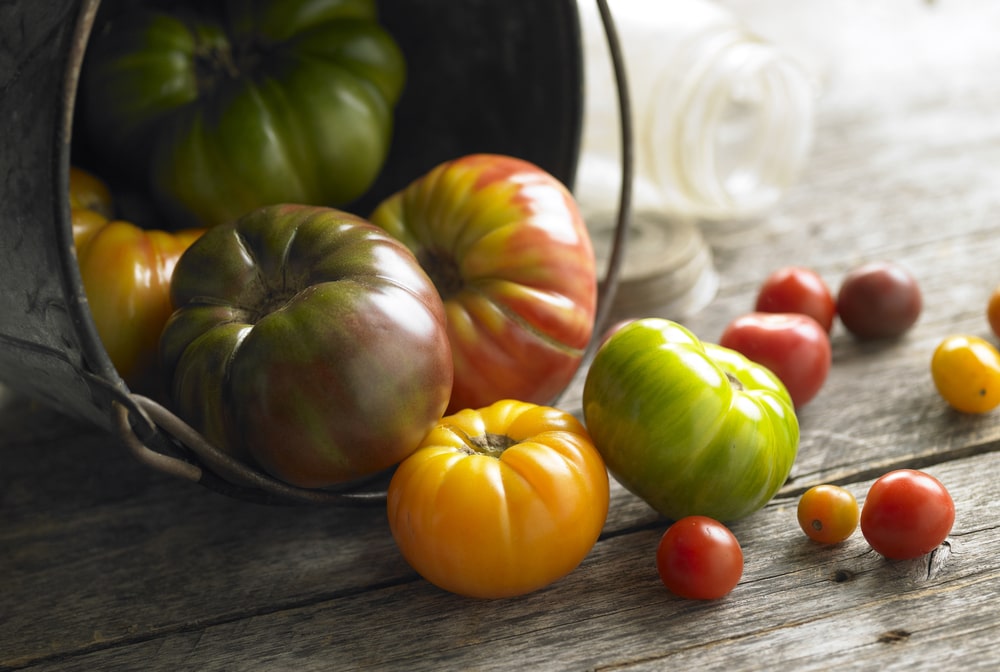From the New World to the Old World to Your Garden – Growing Tomatoes
Tomatoes, or Solanum lycopersicum, are native to the New World—found in Central and South American wilds. In 1519, the explorer Hernán Cortés took seeds back to Europe, where they were planted as ornamentals. People were convinced they were toxic because it was apparent that they were related to the deadly Nightshade. Of course, the foliage and uncooked green fruits do contain toxic alkaloids.
The first tomatoes introduced were probably yellow because, in Spain and Italy, tomatoes were called “pomi d’oro” or “yellow apples.” In France, tomatoes were called “pommes d’amour” or “love apples” as they were convinced they had aphrodisiacal properties.
Italy Experiments and Tomatoes Come Back to North America
While the rest of Europe was convinced that tomatoes were toxic, Italy began experimenting with introducing them into their cuisine. It wasn’t until the early 1800s that tomatoes returned to the New World. Thomas Jefferson grew them as early as 1781 in the gardens at Monticello.
In 1897, a young man named William A. Campbell put condensed tomato soup into a can, and the rest is history.
How Much Sun Do You Need?
To successfully grow tomatoes, you need full, all-day sun—preferably eight or more hours. If you only get six hours, go for it. If you only get five, what I am going to tell you is to lower your expectations. With only four hours of sun, then learn to love leafy greens like collards and kale because chances are you won’t get much of a tomato harvest.
Determinate or Indeterminate – How Do They Differ?
Tomatoes grow one of two ways. Some tomatoes are “determinate.” These tomatoes are sold as bush or patio varieties. They tend to set fruit over a relatively short period of time—usually two to three weeks. This means you tend to get a bigger harvest over a few days—great if you plan to freeze or can tomatoes. They may not produce all summer, however.
Other tomatoes are “indeterminate.” These tomatoes, technically vines, keep growing over the course of the summer and can top out at six, eight, or even ten feet tall, so they need to be staked or trellised.
How to Handle Problems if They Arise
Allow enough room between plants so they don’t touch each other. This way, if one gets a disease or insect pest, it won’t necessarily spread from plant to plant. Unfortunately, tomatoes are prone to a few problems.
One of the most common is blossom-end rot. This is when the bottom of a tomato gets brown and water-logged looking. This often happens with the first flush of fruit—particularly if we’ve had more rain than usual early in the season. It can be the result of a calcium deficiency in the soil. Adding crushed eggshells to your soil will help—in several years when they’ve broken down. Or you can feed with Tomato-tone, an organic vegetable garden fertilizer with calcium.
If we’ve had a lot of rain early in the season, tomatoes can get Early Blight, a fungal disease. Applying an organic fungicide may help. Watering your plants correctly can also help. Don’t get the foliage wet while watering. Water at the base of the plants. Tomatoes can also get Late Blight in late summer after a spell of humid weather. Treat it the same.
Tomatoes are prone to other bacterial and viral diseases, and nothing can be done short of destroying the plant and not planting any other tomato family member there for three years. This is why it is recommended that you rotate crops every three years.
You can plant cucumbers, squash, beans, carrots, etc., but there are no tomato relatives (tomatoes, peppers, eggplants, and tomatillos).
Have Fun and Take the New Variety Challenge!
If you have consistently grown a Better Boy or a Big Boy, I want to challenge you to try a variety you’ve never tried. There are hundreds of varieties—some so similar to the others that you can hardly tell them apart, but others very different. For example, Black Krim and Cherokee Purple are both “purple” tomatoes; however, Black Krim has a light salty back note, while Cherokee Purple has a rich, almost smoky flavor. Shake it up, try something new, and let me know how it works!
Your Tomato Plants Are Waiting
Stop by the Great Big Greenhouse and let us help you choose those “just right” varieties you’ll love.

